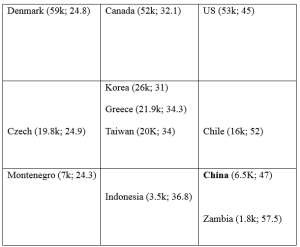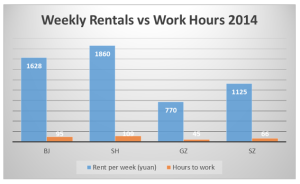36
Jake Lin, Victoria University of Wellington, New Zealand
Urbanization in China has been happening in a breakneck speed in the past 30 years. In 1978, less than 20% of China’s population lived in the cities. Now for the first time in history, China is a more urban country than a rural one; state statistics shows 51.3% of the population lived in cities in 2012[1]. Between urban and rural China, there are worlds of difference. As of 2013, there were 44 cities in China with a GDP per capita value above the World Bank’s threshold line for high-income economies – US$12,746. Of these 44 cities, the GDP per capita in 10 big cities is above $20,000 (World Bank Group, 2015, pp. 145-157). Considering the indicators of population, land area and GDP, there are four megacities in China[2]: Shanghai, Beijing, Guangzhou, and Shenzhen. These four megacities are where most of the Chinese industrial workers try to find jobs to keep their ‘city dreams’ alive.
How unequal is it for the industrial workers in the megacities in China? There was no clear answer for this. Although the national Gini coefficient[3] jumped from below 0.3 in the late 1970s to 0.47 in 2013 higher than most of the developed and developing countries (Figure 1), there are very few statistical indicators that would help us understand inequality levels within megacities in China. A UN study ‘State of the World’s Cities 2010/2011’ shows Gini coefficients in some of the big Chinese cities are relatively higher than the cities in the East Asia region (United Nations, 2008), with the highest Shenzhen standing at 0.49.

However, Gini coefficients do not tell us a lot about who exactly experiences what level of inequality. Before the reform started, megacities were bastions of a good life for the industrial workers. State Owned Enterprise (SOE) workers used to enjoy privileges, the so-called iron rice bowl (Ngai et al., 2012), which the rural population could not even dream of. The stark inequality between urban and rural areas was the direct result of the state crafted institutional division. However, social inequality between the rich elite and the working poor in megacities today emulates the old urban-rural gap.
There are two key reasons for this. First, informal jobs with no contract signed are increasingly replacing formal jobs. This is in spite of China’s central government passing legislation designed to protect the rights of industrial workers. This is best illustrated by what happened after the Labor Contract Law came into force in 2008. Under the Law, if workers get a formal job with contract signed, their employer is required to pay for extra labor costs, such as the ‘five insurances and one fund’ package, overtime pay, and severance pay. However, most of the employers in manufacturing industries know how to get around the regulations by using dispatch workers hired through dispatch agency. Now, more than one-fifth of the urban workers are dispatch workers (Friedman & Lee, 2010, p. 512). Employers using dispatch workers range from private and foreign companies, such as Apple and Nokia, to SOEs, such as Sinopec and China Telecom. For example, 30% of the workforce are dispatch workers in Nokia’s factory. A Ramen noodles franchise owned by a Sinopec subsidiary employs thousands of wait staff through dispatch labor agency in four megacities[4]. Dispatch workers’ temporary status without a formal contract puts them in a precarious position. They are much more likely subject to rights abuses, be lower paid, and being fired for no reason.
Employers in the construction industry use a similar strategy, subcontracting, to save labor cost. According to a report jointly produced by four universities from China and Hong Kong, 97.1% of the construction projects involved subcontracting in China. A study of 4,329 construction workers by two Chinese labor NGOs found that only 5% workers have proper labor contract by the employers[5]. Not surprisingly, perhaps, the number of construction workers protests for payment of arrears increase rapidly over the past ten years, particularly after the economic slowdown and property market downturn in 2012. For example, there were about 243,600 cases of workers disputes caused by wages arrears in 2013[6].
Sanitation workers in the megacities are another group of workers who fare badly under an informal job structure. There are an estimated 38,840 sanitation workers in Guangzhou in 2013, who earn an average of about 1,300 yuan, or US$209, per month (equivalent to the city’s minimum wage)[7]. Most of the local governments in the megacities outsource the sanitation and cleaning work to save cost. Li Tinggui, a former head of Guangzhou Urban Management Committee, said most sanitation companies had won their government contracts with low tenders, which has in turn led to low pay for sanitation workers. Sanitation workers in the four megacities remain one of the lowest paid groups even though they are, in theory, state workers.
The second main reason for rising levels of social inequality is because industrial workers’ real wages have actually declined when taking into account inflation. This has meant that their purchasing power has deteriorated in the megacities. For example, average housing price to income ratio in four megacities have overtaken traditional expensive international cities, such as Hong Kong and Sydney. In 2014, Shenzhen and Beijing’s house price to income ratio were about 15 to 20 times[8], whereas comparable international cities had a ratio of about 10 times. Making urban property beyond affordable for industrial workers. If we compare the industrial workers’ common wages against the average rental prices in the megacities, and consider how many hours workers have to work in order to be able to afford a one-bedroom apartment in the megacities, the results are quite startling (figure 2). In Shanghai, for instance, an industrial worker has to work 109 hours per week if he or she wants to live in a one-bedroom apartment in the urban area. With inflation waxing and waning over the reform period, the purchasing power of the frontline industrial workers’ monthly wages varied. According to one measure of purchasing power, the amount of rice that can be purchased with an average industrial worker’s monthly wage declined from about 295kg in 1990, to 220kg in 2000, and up a bit to 268kg in 2014[9]. That shows to an extent industrial workers struggled most badly in 2000, and they were worse off in 2014 than in 1990.

The stagnant even declining workers’ real wages explains why new forms of urban villages (cheng zhong cun) are emerging in the megacities. Urban villages are the urban slums with Chinese characteristics. They are a mix of rural and urban society within a self-organized grassroots unit, which provides low-cost residential space for migrants and other low-wage earners. In 2010, there were roughly 200 urban villages in Beijing, about 140 in Guangzhou, 104 in Shanghai, and 240 in Shenzhen, with a combined population up to 10 million[10]. This is estimated by the author based on the Chinese media report (for example see link). Cheaper housing is the key alternative offered by these slums when compared to the expensive urban living of the megacities. Now, new and extreme forms of slums have appeared as a consequence of the rising cost of urban living. A group of Beijing residents in Tangjialing are dubbed as the ‘ant tribe’ because of their cheap and poor-quality accommodation. Most of them are hard-working young university graduates and other migrant workers. ‘Scrap villages’ are another new form of slum that thrives in the suburbs of the megacities. Villagers live beside the rubbish dumps and make their living by sorting out scrap metal and other millions of tons of waste, from copper wire, to detergent bottles and anything you can think of. The most recent ‘innovation’ in low cost living is the ‘rat tribe’, who dwell in a deep and dark underground maze of cells in Beijing. Although these new forms of urban slums offer cheaper living alternatives, this comes at the cost of losing basic human facilities, such as medical care, child schooling, and even safety.
In conclusion, the rising social inequality experienced by Chinese industrial workers in the megacities is staggering and beyond the extent in which the Gini index could explain. The Chinese state’s urbanization strategy should strike a careful balance between economic growth and social equality. No one should be working poor, as they say. A series of social welfare policy and programs should be developed to help the low waged industrial workers in China’s megacities.
References
Friedman, Eli, & Lee, Ching Kwan. (2010). Remaking the World of Chinese Labour: A 30-Year Retrospective. British Journal of Industrial Relations, 48(3), 507-533.
Ngai, Pun, Kuruvilla, Lee, Gallagher, Sarosh, Ching, Kwan, & Mary, E. (2012). From Iron Rice Bowl to Informalization: Markets, Workers, and the State in a Changing China. The China Quarterly, 209, 231-232.
United Nations. (2008). State of the world’s cities 2010/2011: UN.
World Bank Group. (2015). East Asia’s Changing Urban Landscape: Measuring a Decade of Spatial Growth: World Bank Publications.
[1] See website http://cpc.people.com.cn/18/n/2012/1104/c351073-19488915.html (access on 25 April 2015)
[2] According the UN report in 2015, city with population more than 10 million people is considered first-tier city. This paper calls the four first-tier cities megacities.
[3] Gini coefficient is a statistical measure designed to represent the income dispersion of residents in a country.
[4] See news report from – http://www.bloomberg.com/bw/articles/2012-03-08/why-chinas-factories-are-turning-to-temp-workers ( access on 25 April 2015)
[5] See a Chinese news website – http://news.sina.com.cn/c/2014-12-13/003431279821.shtml (access on 1 May 2015)
[6] According to statistics from National Bureau of Statistics of China 2015.
[7] See a Chinese news website – http://gd.nandu.com/html/201301/20/17466.html (access on 1 May 2015)
[8] See http://www.china.org.cn/top10/2015-06/30/content_35933216_8.htm (access on 02 July 2015)
[9] This is calculated from the average industrial workers’ wages and market prices of food items in late 2014.
[10] This is compiled from a number of Chinese news reports: http://www.southcn.com/nfdaily/news/content/2014-05/15/content_99763832.htm; http://www.chinanews.com/sh/2014/09-03/6559151.shtml; http://news.xinhuanet.com/fortune/2013-02/19/c_124361393.htm; http://news.sohu.com/20110411/n280221249.shtml. (access in 23 June 2015)
Acknowledgement
This essay is written based on some of the research findings of a conference paper ‘Inequality, Class and the Emerging New Workers in China’s Megacities’, which is to be published by International Journal of Political Science, Law and International Relations in October 2015. The author would like to thank the Faculty Research Committee Grant at the Victoria University of Wellington for providing funding support, and the Institute of Population and Labour Economics, at the Chinese Academy of Social Sciences for their hosting my visiting research and field study in 2014. Thanks also go to my supervisor Professor Xiaoming Huang and Dr. Jason Young, and a couple of anonymous reviewers for their constructive comments.
Author Biography
Jake Lin is a Ph.D. candidate at the School of History, Philosophy, Political Science & International Relations, Victoria University of Wellington, New Zealand. His research interest broadly focuses on political science and international relations, primarily on the Asia Pacific region. He is particularly interested in labor politics, inequality and contemporary capitalism, urbanization and development, from a historical and sociological perspective.
Contact email: jake.lin@vuw.ac.nz
